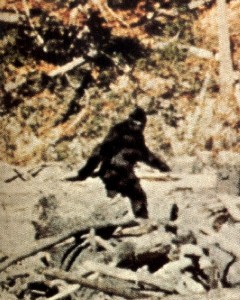Yahoo News contributor Bonobomichael released the following article that states that odd tracks were found in a campsite near La Queva Creek, New Mexico.
The footprints are said to be that of a family of Sasquatches according to the article.
The prints consisted of three sets from three distinct individuals. Two were of the typical Sasquatch type: splayed toes, wide heel and forefoot with the typical mid-tarcel break. The third was of an apparant juvenile and of the same general shape, but perhaps ten inches long by four inches wide from heel to toe, with the splayed toe area slightly wider. The two apparent adults varied in several repects from each other.
One apparent adult had feet measuring about 17 inches long by six inches wide and of uniform appearance from toe to heel. Dermal ridges were absent from all three individuals in the two day old mud. The seventeen inch prints were compressed into the aluvial soil in spots perhaps three inches deep and varied in depth according to the soil consistency and the apparent activity of the individual. The other apparent adult set of prints were approximately fourteen inches long and about five inches wide. The right foot of this individual showed evidence of severe healed trauma. This print was curved inward and of a sycle shape, presented itself consistently over the whole range of prints, and generally, when the individual appeared to be standing in a stationary pose with the smaller individual cradled between the adult individual’s legs, appeared less impressed into the soil as if the indiviual had been favoring this limb
So far, no photographs of the footprints were made publicly available. Only the detailed report tells of the distinctive features that these footprints are said to have.
Full source: Associated Content
13 commentsMy companion and I, after learning that the New Mexico State Police had looked into a report from campers about strange sounds and huge footprints near La Queva Creek in Glorita, New Mexico, found a series of huge
footprints in the area and followed them for approximately three quarters of a mile over varied mountain terrain until they faded out on an extrensive rock outcropping.
The prints consisted of three sets from three distinct individuals. Two were of the typical Sasquatch type: splayed toes, wide heel and forefoot with the typical mid-tarcel break. The third was of an apparant juvenile and of the same general shape, but perhaps ten inches long by four inches wide from heel to toe, with the splayed toe area slightly wider. The two apparent adults varied in several repects from each other.
One apparent adult had feet measuring about 17 inches long by six inches wide and of uniform appearance from toe to heel. Dermal ridges were absent from all three individuals in the two day old mud. The seventeen inch prints were compressed into the aluvial soil in spots perhaps three inches deep and varied in depth according to the soil consistency and the apparent activity of the individual. The other apparent adult set of prints were approximately fourteen inches long and about five inches wide. The right foot of this individual showed evidence of severe healed trauma. This print was curved inward and of a sycle shape, presented itself consistently over the whole range of prints, and generally, when the individual appeared to be standing in a stationary pose with the smaller individual cradled between the adult individual’s legs, appeared less impressed into the soil as if the indiviual had been favoring this limb.
Five distinct areas of grouping were found, two behind large trees, one behind an earthen embankment, and one in a brushy ravine. The indiviual leaving the largest prints was consistently separated from the other
apparent adult and juvenile in these groupings by about twenty feet and consistently in a forward position, uphill from the other two. In two distinct, open areas evidence of “playing” or “frolicking” was evidenced by the confused nature and large number of prints left by the apparent juvenile member of the group. In these areas slipping and sliding is apparent in the distortion of the prints. In these groupings the smaller apparent adult was positioned in a stationary position facing the large grouping of “frolic” prints left by the apparent juvenile. The larger apparent adult left prints facing away from the other two individual approximately twenty to thirty feet away and uphill from this group.
No noises other than normal forest noise was noted while following these tracks by the investigators, nor were any out of place smells noted although on one occasion the two Rotweilers accompanying us barked furiously in the dirrection of the heaviest part of the forest and cowered between our legs for the rest of the walk back to the road. This was approximately one hour after discovering a large, dead cottonwood slab with its softer, inner parts torn and shreaded away leaving an eight foot slab resembling a dugout canoe or a medium wooden sater trough. At this area I tried some “tree knocking” to see if there might be a response. There was not, and nothing notable occured until the cowering of the Rotweilers, a breed known for its courage, not for timidity.
No conclusions can be, or are drawn from this apparent evidence in the form of footprint trails through the woods of the Sangre De Christo Mountains in Northern New Mexico other than something heavy with huge human-like bare feet left prints over a large area in the vicinity of La Queva Creek in Glorieta, New Mexico. No evidence seems to exist in the logs of the New Mexico State Police even though numerous residents of the area related that two State Police cars were parked by the side of the La Queva Creek Road for several hours on, or about the afternoon of June 10th in the same area as the author and his companion found the series of footprints described here.





